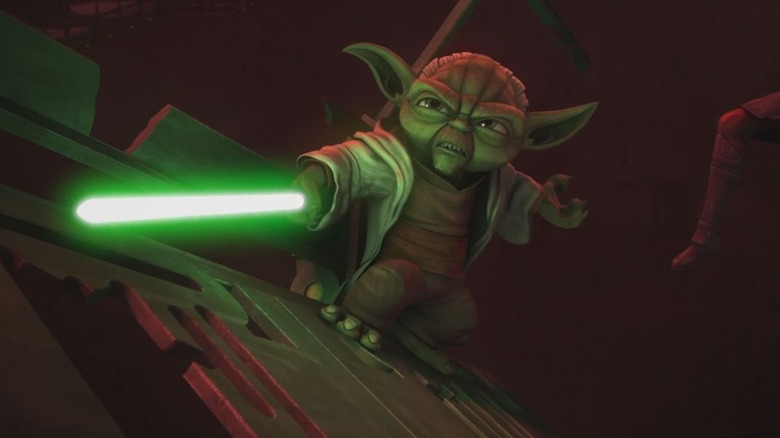Star Wars: The Deadliest Lightsaber Technique That Nobody Uses
The Star Wars universe is full of secret Force techniques, forbidden lightsaber maneuvers, and ancient dark side powers. When you've got decades upon decades of lore spreading across every conceivable medium — and two distinct timelines — that's inevitable. The main movies and TV shows only show a fraction of what the Jedi, Sith, and other Force users are capable of, but they're still packed with stylish moves. However, there's one particularly dangerous lightsaber technique we hardly ever see.
Some fans may be familiar with Tràkata, a fighting form from Star Wars Legends centered around turning your lightsaber on and off repeatedly in combat. Doing so could be disorienting to an opponent, but it was also seen as dishonorable. As a result, both Jedi and Sith typically agreed not to use this tricky lightsaber move.
But what about taking that same principle of Tràkata and inverting it — turning off your opponent's lightsaber in the middle of a fight with the Force rather than your own? There are several documented instances of this happening in Star Wars, including a few cases in the modern Disney canon. But if it's possible and clearly effective, why don't we see more Force users employ this deadly technique during combat?
A brief history of Force users turning off their opponents' lightsabers
There's not a lot of official writing on the technique of turning off your opponent's lightsaber with the Force. However, we have seen masters use this move a couple of times. In the very first episode of "Star Wars: The Clone Wars," Yoda deactivates Asajj Ventress' lightsabers and pulls them right out of her hands. He's not actively dueling her, but he comments that she's "not that strong" with the dark side. In "Star Wars Rebels," Ahsoka Tano uses a similar move while fighting the Seventh Sister. In that instance, she deactivates her own lightsabers, physically grabs her opponent's hilt while the Inquisitor is pressing it down at her, and turns off the blade. Ahsoka may use the physical switch here, given the proximity, but the Seventh Sister's reaction suggests it's a Force move.
While far from a common technique, this move has become something of a meme in the Star Wars fan community. Many debates have raged over the technique and why it doesn't occur more frequently. YouTuber Matthew McCleskey even made a comedy sketch video spoofing the idea, in which he jokes that Obi-Wan Kenobi's death by Darth Vader is the result of the Sith Lord turning off his old master's weapon. Of course, there are reasons why we rarely see this trick come out in actual Star Wars stories.
Turning off your opponent's lightsaber with the Force is incredibly difficult
It's clear from the examples listed above that turning off your opponent's lightsaber with the Force is possible. Some fan theories based on old Legends lore suggest that a smaller version of the Force barrier or "protection bubble" technique — an Expanded Universe power — was used to protect a Jedi's immediate person from Force attacks. A version of that may still be true, but the real answer is probably more complicated.
Lightsaber battles happen incredibly quickly, with combatants often using the Force to predict their opponents' moves milliseconds ahead of time. Catching the switch of a saber hilt in all that chaos is a precise and potentially disastrous move — one that generally isn't worth the risk. When we do see the technique employed in canon, it's during calmer moments when one fighter has an opportunity to fully focus. It's also worth noting that neither Ventress nor the Seventh Sister are top-tier Force users or duelists when they fall victim to the technique. Attempting it on a true master likely wouldn't work due to their awareness and control.
Lastly, this treacherous move would likely be seen as dishonorable in the same way Tràkata is. When we see it, it's more of a power play — a sign that one warrior clearly isn't ready yet to face off against the other.


